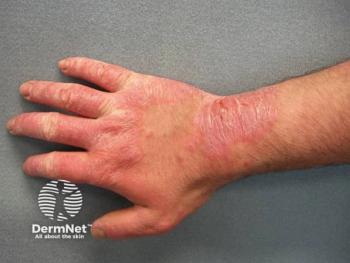
Age Influences Allergen Sensitivity and Reaction Severity in Patch Testing
Key Takeaways
- Older adults show fewer and less intense positive reactions to allergens compared to younger individuals, with distinct sensitivity patterns and dermatitis distributions.
- Nickel sulfate is the most prevalent allergen in both age groups, but younger adults are more commonly affected.
Elderly patients show lower and more mild patch test reactivity than younger individuals, with different sensitization patterns.
Older adults demonstrated fewer and less intense positive reactions on patch testing than younger individuals, with distinct allergen sensitivity patterns and anatomical distributions of dermatitis, according to a recent study published in JEADV Clinical Practice.1
The findings suggest age-related immune changes significantly influence the presentation and diagnosis of allergic contact dermatitis (ACD).
Background and Methods
Cumulative lifetime exposure to allergens may increase the risk of sensitization,2 making age-related trends in ACD complex and sometimes contradictory.
To better define these trends, investigators performed a retrospective observational analysis of patch test results in 2377 patients suspected of having ACD between 2006 and 2019. Patients were divided into 2 age groups: elderly (≥65 years, n = 709) and younger adults (18–40 years, n = 1668). Patch testing used the SIDAPA standard series,3 supplemented with selected allergens based on North American Contact Dermatitis Group protocols. Test sites were assessed on day 2 and day 2, following ICDRG guidelines.
Results from this contemporary cohort were also compared with historical patch testing data from the same institution (Padua Dermatology Clinic, 1997–2001) to assess temporal changes in sensitization patterns.
Findings
The rate of positive reactions to at least 1 allergen was significantly lower in the elderly (62.6%) than in younger adults (71.5%). Elderly patients were 33% less likely to have a positive test result (OR = 0.67, 95% CI: 0.55–0.81). Additionally, the presence of multiple contact allergies were more common in the younger group (41.3%) compared to the elderly (36.0%).
Furthermore, nickel sulfate was the most prevalent allergen in both groups but significantly more common in younger adults (35.5%) than in the elderly (17.8%). Cobalt and thimerosal sensitivity exhibited similar trends across age groups.
In contrast, older patients had higher rates of sensitization to balsam of Peru (13.6% vs 7.0%), neomycin, fragrance mixes, and preservatives such as Euxyl K400.
Study authors noted that these patterns likely reflect differing exposures, with younger patients may be more frequently in contact with metals through piercings, jewelry, and occupational sources, while older adults may be more exposed to topical medications, antiseptics, and personal care products commonly used to treat chronic skin conditions.
The most commonly-affected sites of dermatitis differed between groups. In elderly patients, the face was the most frequent site (38.1%), followed by the trunk (24.8%) and lower limbs (22.5%). Younger patients more often presented with hand dermatitis (40.2%) and were also more likely to have eczema on the feet and neck.
Hand involvement in younger adults may result from increased exposure to irritants and allergens in workplace settings, while facial and lower limb involvement in older adults may stem from chronic dermatoses treated with sensitizing topical agents.
Reaction intensity was also lower in the elderly. Strongreactions occurred more frequently in younger adults (36.4%) than in older individuals (22.4%), particularly in response to nickel. While both age groups showed increasing reaction intensity from day 2 to day 4, the trend was more pronounced in the younger cohort (60.6% vs 53.9%).
Compared with historical data from 1997 to 2001,4 positivity rates and multiple allergen sensitivities have increased in both age groups. In the prior cohort, only 40.7% of elderly and 47.8% of younger patients reacted to at least 1 allergen.
Conclusions and Future Directions
The retrospective study highlights that older adults with suspected ACD are less likely to have positive patch test results, and their allergic responses tend to be milder and involve different allergens and body sites than in younger patients.
"While allergen exposure patterns evolve over time, age remains a major factor modulating both the frequency and intensity of ACD," wrote study authors Mazzetto et al. "Patch test responses of older patients exhibit fewer positive reactions and less frequent MCA than younger individuals."
Moving forward, clinicians should be mindful of differences in exposure history, immune responsiveness, and skin barrier function when evaluating contact dermatitis in patients of all age groups, particularly in elderly patients.
References
- Mazzetto R, Soldi E, Ventura L, Deotto L, Caroppo F, Fortina AB. Allergic contact dermatitis: A comparative study of elderly and young over time. JEADV Clin Prac. July 13, 2025.
https://doi.org/10.1002/jvc2.70126 - Burbank AJ, Sood AK, Kesic MJ, Peden DB, Hernandez ML. Environmental determinants of allergy and asthma in early life. J Allergy Clin Immunol. 2017;140(1):1-12.
doi:10.1016/j.jaci.2017.05.010 - Stingeni L, Bianchi L, Caroppo ES, et al. The new Italian SIDAPA Baseline Series for patch testing (2023): an update according to the new regulatory pathway for contact allergens. Ital J Dermatol Venerol. 2024;159(2):83-104.
doi:10.23736/S2784-8671.24.07733-8 - Piaserico S, Larese F, Recchia GP, et al. Allergic contact sensitivity in elderly patients. Aging Clin Exp Res. 2004;16(3):221-225.
doi:10.1007/BF03327387
Newsletter
Like what you’re reading? Subscribe to Dermatology Times for weekly updates on therapies, innovations, and real-world practice tips.



















